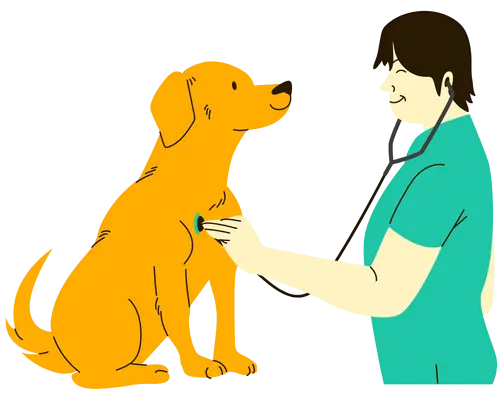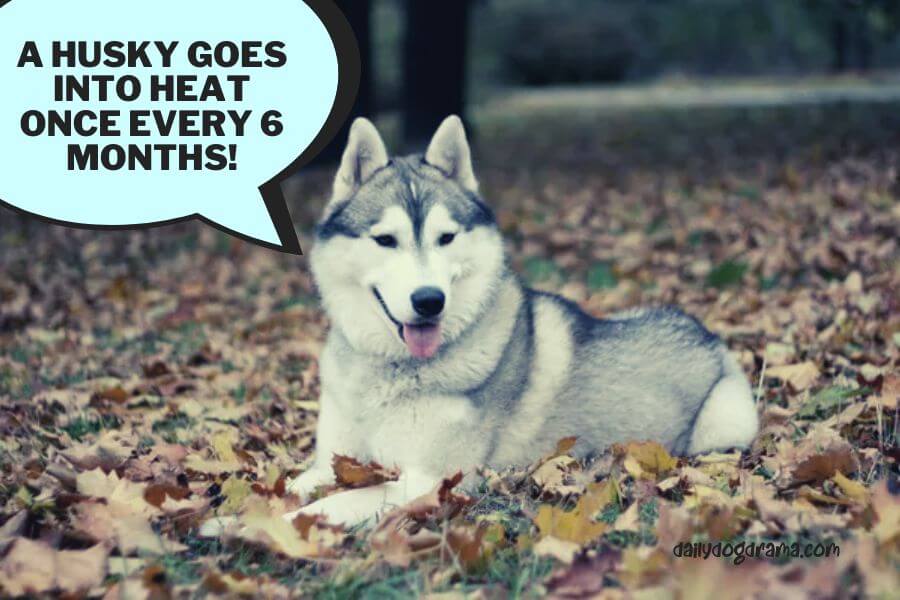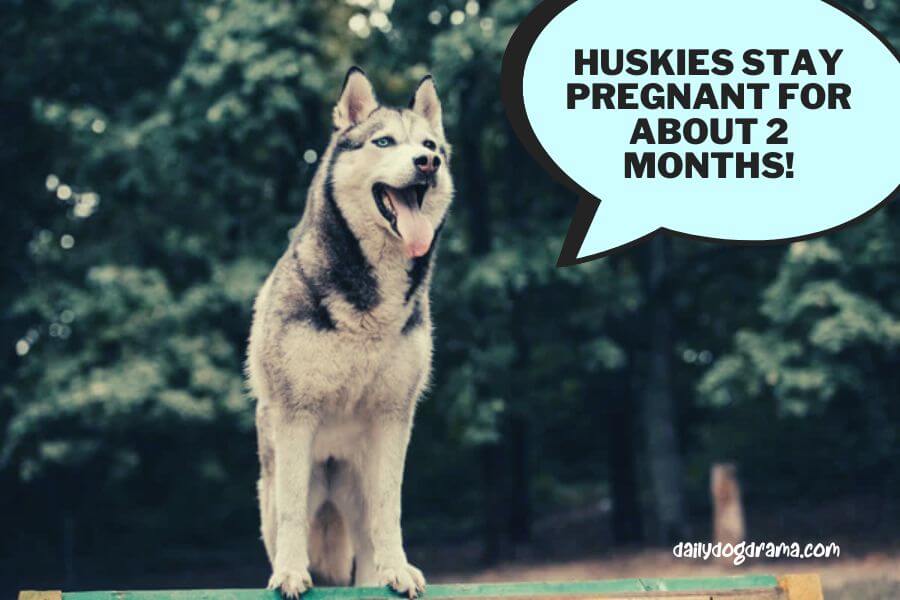Do you know what DOG ESSENTIALS you are missing out? Find out now!
Zack Keithy, our author, is a certified veterinarian technician (UC Blue Ash) for over 6 years (contact him here). The articles written here are based on his expertise and experience, combined with a review by our expert vet reviewers including Dr M. Tarantino. Learn more about us here.
Huskies are known for their beautiful fur and adorable faces, but did you know that they also make great parents?
They are some of the most loving parents in the animal kingdom, and they love having lots of babies around.
If you planning to have more of them in your home, breed them, or maybe your husky is pregnant now, you may be wondering: How many puppies can a husky have?
A Siberian Husky has on average 5 puppies in a litter. Most commonly, this number ranges from 4 to 6 puppies. This number varies though, and it is quite common to see first litters have only 4 or fewer puppies.
In this post, we shall look into the numbers a bit more in detail, talk about the factors that can influence litter sizes, and handling a husky pregnancy.
Medical Questions? Talk to a Veterinarian 24/7.
Connect one-on-one with a licensed vet who will answer your questions in minutes.
*Article may contain affiliate links to retailers like Amazon and Chewy. Learn more on our disclosure page.

- How Many Puppies Can a Siberian Husky Have in One Litter?
- How Many Healthy Litters Can a Siberian Husky Have in Their Lifetime?
- What Determines the Number of Siberian Husky Puppies in a Litter?
- At What Age Can You Breed a Siberian Husky?
- What Age Do Siberian Huskies Go in Heat?
- How Do You Know if Your Siberian Husky is in Heat?
- How Often Do Siberian Huskies Go Into Heat?
- How Long Does a Siberian Husky Stay in Heat?
- How to Tell if My Siberian Husky is Pregnant?
- How Long is a Siberian Husky Pregnant for?
- How Do I Know When My Siberian Husky is About to Give Birth?
- Care Tips for a Pregnant Siberian Husky
- Should You Breed a Siberian Husky?
- Frequently Asked Questions (FAQs)
- In Conclusion: How Many Puppies Can a Husky Have?
How Many Puppies Can a Siberian Husky Have in One Litter?

The average litter size for a Siberian Husky is between 4 to 6 puppies.
Once in a while though, you would find a dam that has 7 or 8 puppies in one litter, but at times, this number can be just 1 or 2. These numbers are really quite uncommon though.
The size of the litter can be influenced by the breeding lines; some lines tend to have larger litters than others.
Husky owners who are considering breeding their dogs should talk to a veterinarian or breeder about the size of the anticipated litter.
Many other variables, which I go into more detail about in the sections below, will also affect how many puppies there are in a litter.
How many puppies can a Husky have the first time?

There is no fixed guide as to the number of puppies a Husky can have in its first birth.
However, some breeders and experts suggest that Huskies may have smaller litters in their first birth due to the immaturity of the reproductive system in younger females.
The number is also influenced by a myriad of factors which I discuss in this article.
How Many Healthy Litters Can a Siberian Husky Have in Their Lifetime?
Siberian Huskies, and in fact all dogs, do not go through menopause and are able to reproduce until they pass away.
They go through two heat cycles a year, each lasting six to eight months.
However, it does not follow that they should mate twice a year just because they can.
Huskies shouldn’t be mated more than once a year and shouldn’t be bred more than four to six times in their lives.
This is to ensure that it can be spayed and live a happy life even after retiring.
Add to the fact that there are nations where it is illegal to breed a dog more than four to six times in its lifespan, and you should understand the importance of not overbreeding.
In the US, the American Kennel Club (AKC) does not accept registrations for dams that are bred over the age of 12 and under 8 months, and sires that are over the age of 12 and under 7 months.
What Determines the Number of Siberian Husky Puppies in a Litter?
In this section, we’ll discuss the key factors that determine the number of Husky puppies in a litter.
1. Age of the dam
In general, the size of the litter gets smaller as the dam gets older.
Oddly enough, the first couple of litters are frequently smaller than the future litters, so once your Husky breeds again after the first two litters, you should prepare to have one or two extra puppies.
It’s also important to note that it is not recommended to breed a dog after the age of seven or eight because it is too late to have puppies and it could lead to health issues for both the mother and the babies.
Your dog should be spayed long before that, if at all possible, as this will enhance its general health.
2. Age of the sire
The father of your Husky’s litter will also have an impact on the litter size, although less so than the mother.
Even if the female is exceptionally productive, there may be fewer puppies in each litter because a dog’s sperm quality begins to drop at the age of 5 to 6.
Occasionally, breeders have to rely on artificial insemination to aid in breeding older males, which is why it is better to only breed when they are younger.
3. Health of the mom
If you intend to reproduce your Huksy, its health must come first.
The plain fact is that an unfit puppy will be born to a weak or unhealthy mother.
Therefore, if you choose to breed your dog, one of the most important things to do is to keep an eye on the mother’s weight while she is expecting.
For example, if the mother is obese, she may experience joint issues and, similar to a human mother, make labor and delivery more challenging.
Avoid overfeeding your dog to prevent obesity, which will result in needless issues.
The best food for a pregnant dog is one that is wholesome, balanced, and palatable.
Additionally, it should be emphasized that the duration between litters must be sufficient to provide your girl time to heal (hence no breeding in consecutive heat cycles).
Hey there, sorry to interrupt but I wanted to tell you about an online vet service I’ve been using for years.
An in-person visit with one is great, but it’s not always an option.
Now, thanks to technology, you can speak to one without leaving your home.

Got something to ask a vet?
Talk to one anytime, 24/7.
* Don’t use this service for emergencies.
Alternatively, a vet can come out to you instead (exclusive to our readers: use THEVETS15 for 15% off).
SCHEDULE AN APPOINTMENT HEREThank you. The rest of the article continues below.
4. Size of dog
The Husky is considered to be a medium-sized dog, so in this regard, it will be able to have a few more puppies than a small size dog in comparison.
Within the breed itself, Husky sizes also vary, and the bigger one is, the more likely it will have a larger litter.
I don’t just mean heavier in terms of weight when I say that; I also mean larger in terms of build.
5. Litter in which mom was born
The level of fertility in your Husky has a thing or two to do with the litter it was born in.
If she was born into a large litter herself, she will likely have a larger first litter.
On the other side, you may generally anticipate that your girl will have a small first litter if she was born in a small litter herself.
6. Type of breeding
Actually, considering how easily it could grow complex, it would be wiser to save this topic for a later essay.
But for now, just be aware that the reproduction process can have a considerable impact on both the quantity and quality of puppies.
For instance, if inbreeding is excessively severe, the quality of a litter may decline.
Not only will litter sizes be smaller, but shorter lifespans and a higher likelihood of genetic disorders will also have an impact on the health of the puppies.
As the bonds between the dogs deepen, these issues are more likely to arise.
Linebreeding, on the other hand, aims to maintain sufficient genetic diversity while preserving the best genes from a bloodline, making it frequently a safer method of dog breeding.
7. Time of breeding
It is said that a dam is more likely to have a larger litter size the closer she is to ovulation.
This is defined as the period after the estrogen period when the Luteinizing hormone triggers ovulation.
Unfortunately, I have not been able to find any studies supporting this theory, so at this point, I would say this factor is probably not that significant.
At What Age Can You Breed a Siberian Husky?
It is technically possible for Siberian Huskies to start reproducing once they reach their first heat cycle, however, this is usually not a good idea and should be avoided.
The first heat cycle usually occurs when the dog is 6 to 12 months old, which is far too young to begin reproducing.
In order to give your dog enough time to develop sexually and put on weight and size, it is advised to wait until she is at least in her second heat cycle.
That said, most ethical and responsible breeders will wait till a Husky is at least 2 years old before breeding them as they would have completed all the necessary medical checks by then.
What Age Do Siberian Huskies Go in Heat?
Most female Huskies go through their first heat cycle between the ages of 6 and 12 months.
If your girl hasn’t gone through her first heat cycle by the time she is 18 months old, speak with your veterinarian to rule out any underlying medical conditions.
A useful rule of thumb is that it will go into heat at about the same age that its mother did.
How Do You Know if Your Siberian Husky is in Heat?
Bloody discharge, receptivity to male dogs, agitated behavior, and many other symptoms can be signs of a dog in heat.
Here’s a breakdown:
- Swollen vulva
- Discharge from the vulva
- Receptive to male dogs
- Change in appetite
- Excessive licking of the genital area
- Agitated, anxious, or aggressive behavior
- Urinating more frequently
- Holding its tail close to the body
How Often Do Siberian Huskies Go Into Heat?

A Husky will go into heat about once every 6 months, but this can vary depending on each individual dog.
While some dogs’ cycles could be a little bit longer or shorter than others, you should be keeping track of when they happen.
Consult your veterinarian to determine whether there is anything that could be causing your dog’s variable seasons.
There is often more time between seasons as dogs get older (but can still get pregnant).
How Long Does a Siberian Husky Stay in Heat?
When a dog is said to be in heat, we are usually referring to the estrus phase of the heat cycle, and that’s the time when they actually see “action”.
The entire cycle is as follows, and it is during the estrus period when a dog will show all the signs discussed above:
- Phase 1: Proestrus (~7 to 10 days)
- Phase 2: Estrus (~5 to 14 days)
- Phase 3: Diestrus (~10 to 140 days)
- Phase 4: Anestrus (~6 months)
How to Tell if My Siberian Husky is Pregnant?
Here are the most common signs that your Siberian Husky is pregnant:
- Nipples enlarged
- Increased hunger
- Irritability (may have a short temper)
- Decrease in activity and energy levels
- Behavioral changes
- Weight gain
- Starts nesting
- Seeks more attention
When you notice all of these happening, and about 25 days have passed since mating, you should bring your girl to the vet for an ultrasound or a blood test to determine if it’s pregnant.
How Long is a Siberian Husky Pregnant for?

Dogs, no matter the breed, are usually pregnant for 56-64 days, or about 2 months.
There won’t be many, if any, obvious indicators of pregnancy in the first two weeks in your dog as the changes are currently taking place internally within the uterus.
However, your Husky will soon start to lose hair around the breasts, develop larger, darker nipples, and develop darker nipples at around 3 weeks of pregnancy.
How Do I Know When My Siberian Husky is About to Give Birth?
It is good to be aware that dogs usually give birth around 2 months (56 to 64 days) after getting pregnant so that you can prepare for it.
As the time draws nearer, there will be a number of telltale signs that your dog might be whelping soon.
- Restlessness
- Vomiting
- Not eating much
- Digging and scratching
- Lethargy
- Start producing milk
- Spending more time in her “nest”
- Shivering
- Panting
- Straining
- Drop in body temperature
Care Tips for a Pregnant Siberian Husky
Pregnant Huskies can be a joyous occasion, but they also require some extra care.
It is so important to keep your dog healthy and happy during pregnancy as this will help them stay comfortable and make sure that they have a smooth delivery.
Here are some tips:
Regular checkups
You need to schedule regular checkups with your vet, especially in the last 3 weeks of pregnancy, or if you notice any changes in your dog’s behavior.
This will help make sure that everything is going as it should be during pregnancy and birth.
Balanced diet
During pregnancy, your Husky really needs to have a balanced diet that is palatable and easily digestible.
This means that she should get plenty of protein (chicken is a good choice), and some fruits and vegetables for vitamins and minerals.
You can also supplement the diet with calcium tablets or other supplements if you want to be extra careful about making sure your dog gets everything she needs during this time.
Quiet environment
If this is your dog’s first litter, it’s extremely important to ensure she has a tranquil environment.
Keeping her calm will assist to avoid problems both for the puppies and during labor.
If you know there will be loud noises, such as fireworks or other people in the house, keep your Husky inside and away from those times so she won’t be startled by the commotion.
Activity
Despite the fact that pregnant dogs shouldn’t engage in strenuous exercise, they can still benefit from attention, light play, and regular short walks.
They shouldn’t be overstimulated, but you also shouldn’t let her become too passive, which can easily lead to health problems.
During this time, I recommend you let your dog have up to two walks each day that stretch up to 15 minutes each.
A pregnant dog must be kept apart from other dogs and animals during the final three weeks of pregnancy; as a result, allow her to get some light exercise inside during this time rather than taking her outside.
Should You Breed a Siberian Husky?
The Siberian Husky has become a popular breed for people who want to breed dogs.
Their popularity makes them an easy choice for breeding, but that doesn’t mean it’s the right one.
Needless to say, there are many things you need to consider before deciding if breeding is right for your dog, and these considerations should be taken seriously.
Siberian Huskies are not an easy breed to breed.
They require careful planning, a large amount of time, and an understanding of what it takes to successfully breed and raise puppies.
Breeders need to be aware that some health issues may arise in their puppies later in life, although this can be minimized by carefully choosing which dogs are used as breeding stock.
Next, also consider the expenses that will be involved.
If you don’t have enough money set aside for these expenses before getting started with breeding Siberian Huskies, then it might not be worth doing at all!
For dog owners who want to have more members in their family, adopting a dog will make more sense.
You get a new dog, and your dog gets a new family!
Frequently Asked Questions (FAQs)
Can a Husky have 11 puppies?
It is highly unlikely for a Husky to have 11 puppies in one go, although there are records of Huskies having 10 puppies in a single litter.
What is the best age to breed a Husky?
The ideal age to breed a Husky is above 2 years old because this gives them time to develop, reach adult size, and reach sexual maturity. They would have already undergone all required medical examinations to determine whether they are healthy enough to breed by this point. Breeding should stop by 7 years old.
Can brother and sister Huskies have babies?
Yes, brother and sister Huskies can have babies, and this is a form of dog inbreeding. However, this is considered bad practice as dogs that are so close genetically will have a higher risk of long-term health complications.
How many times can a Husky get pregnant in a year?
A female Husky, like most dogs, typically comes into heat (estrus) twice a year, although the frequency can vary among individual dogs. This means that a Husky can get pregnant twice in a year, but it is not recommended and unethical to breed them this way.
In Conclusion: How Many Puppies Can a Husky Have?
I’ve covered a lot of ground here, so hopefully, you feel more knowledgeable about the size of Husky litters and what influences them.
If you’re not sure whether you should breed them, think about adopting one from a shelter or rescue group instead.
There are lots of them that really need our help, home, and love.
Check out the litter sizes of other dog breeds here.
You’ve made it to the end, but I hope it’s not the end of our journey. We want to hear your voice! Share your thoughts, problems, suggestions, or anything related to your dog in the comments section. And don’t forget to join our newsletter today too.




